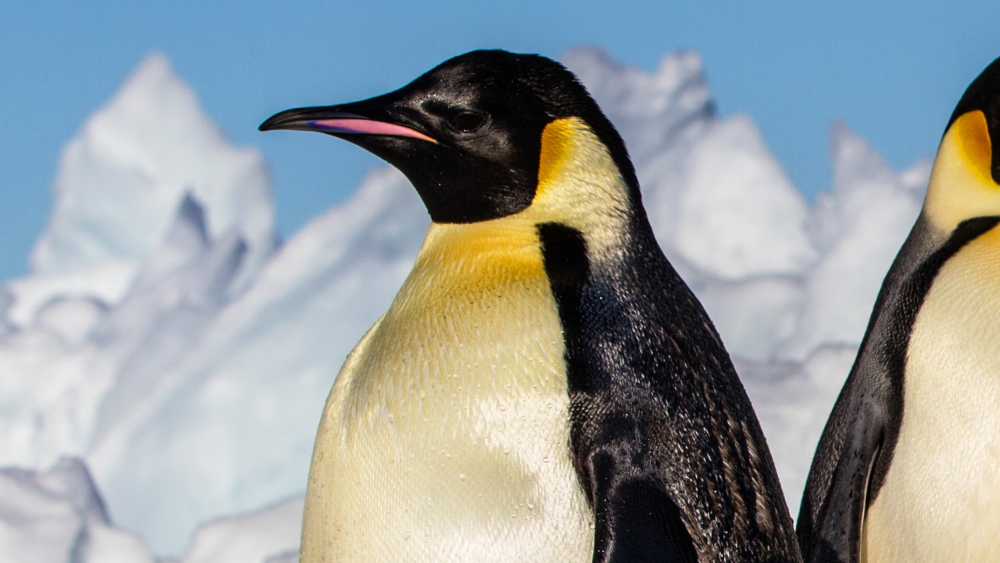Emperor Penguins, the largest of all penguin species, hold an iconic status among Antarctic wildlife. These majestic creatures are not just fascinating for their sheer size and striking appearance but also for their incredible adaptability and resilience in one of the harshest environments on Earth. From their unique breeding habits to their remarkable survival strategies in the frigid Antarctic wilderness, Emperor Penguins stand as a testament to the wonders of nature.
Physical Characteristics
Emperor Penguins (Aptenodytes forsteri) are instantly recognizable by their distinctive black and white plumage, which serves as effective camouflage in the sea, protecting them from predators such as leopard seals and orcas. They boast a sleek, streamlined body adapted for life in the water, with wings that function more like flippers for agile swimming. Standing at an impressive height of up to 4 feet (1.2 meters) and weighing between 22 to 45 kilograms, these birds are true giants among their penguin relatives.
Their large size helps them conserve body heat in the extreme cold of Antarctica. Emperor Penguins have a thick layer of blubber beneath their skin, providing insulation against the freezing temperatures that can plummet to as low as -40°C (-40°F) during the Antarctic winter. Additionally, they possess a unique adaptation known as a counter-current heat exchange system, which helps prevent heat loss from their extremities, such as their flippers and feet, by conserving warmth within their bodies.

Life in the Antarctic
Emperor Penguins exclusively live in Antarctica, where they inhabit the sea ice and surrounding coastal areas. Unlike other penguin species that breed during the Antarctic summer, Emperor Penguins have a unique breeding cycle that is synchronized with the harsh winter months. In March, at the onset of the Antarctic winter, they embark on an arduous journey from their feeding grounds at sea to their breeding colonies located inland.
These colonies, often situated far from the coast, provide a relatively stable environment shielded from the worst of the Antarctic storms. Here, Emperor Penguins gather in large numbers, forming tightly packed huddles to conserve warmth and protect themselves from the biting winds. The colonies can consist of thousands of individuals, creating a cacophony of calls and bustling activity amidst the vast white landscape.
Breeding and Parental Care
Emperor Penguins exhibit remarkable breeding behavior that is both fascinating and awe-inspiring. Upon reaching the breeding colonies, they engage in courtship rituals, with males performing elaborate displays to attract mates. Once a pair bond is formed, the female lays a single egg and transfers it to the male, who carefully incubates it on his feet, nestled against a warm brood pouch for approximately two months.
During this incubation period, males endure the brutal Antarctic winter, enduring weeks of darkness and extreme cold without feeding. They rely solely on their fat reserves to sustain them, losing up to 20-25% of their body weight during this time. Meanwhile, the females return to the sea to replenish their own energy reserves through feeding, undertaking long and perilous journeys across the icy waters.
After hatching, the chicks remain under the protection of their fathers, who continue to provide warmth and care while the females return to the breeding colonies to feed. Once the females return, they take over the care of the chicks, while the males embark on their own journey to the sea to replenish their depleted bodies. This cycle of parental care ensures the survival of the chicks in the harsh Antarctic environment.
Feeding and Foraging
Emperor Penguins are skilled hunters, relying primarily on fish, squid, and krill for sustenance. They are capable of diving to remarkable depths of up to 500 meters (1,640 feet) and can remain submerged for over 20 minutes, utilizing their streamlined bodies and powerful flippers to navigate the icy waters with precision.
Their diet primarily consists of Antarctic silverfish, lanternfish, and squid, which they capture using their sharp beaks and swallow whole underwater. During the breeding season, adults undertake long foraging trips, traveling vast distances from the breeding colonies to find food for themselves and their chicks. These foraging trips can last for several days, requiring immense endurance and navigation skills to navigate the treacherous sea ice.
Conservation Status
While Emperor Penguins are not currently considered endangered, they face significant threats from climate change and human activities. The loss of sea ice due to rising temperatures poses a grave risk to their habitat and food sources, disrupting their breeding and foraging patterns. Additionally, pollution and overfishing in the Southern Ocean can further impact their food supply, leading to declines in population numbers.
Efforts to conserve Emperor Penguins and their habitat are crucial for ensuring their long-term survival. This includes establishing marine protected areas, monitoring breeding colonies, and conducting research to better understand their behavior and ecological needs. By taking proactive measures to mitigate the impacts of climate change and human activities, we can help safeguard the future of these magnificent creatures and preserve the rich biodiversity of Antarctica.
Conclusion
Emperor Penguins are truly remarkable creatures, embodying the resilience and adaptability of life in the Antarctic. From their extraordinary breeding habits to their prowess as skilled hunters, they have captivated the imagination of scientists and nature enthusiasts alike. As stewards of the planet, it is our responsibility to protect and preserve these majestic birds and the fragile ecosystems they inhabit.
So,by working together to address the challenges they face, we can ensure that future generations continue to marvel at the wonders of the Antarctic and the enduring legacy of the Emperor Penguin.









